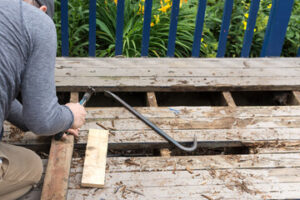Plumbing emergencies can happen when least expected and often require immediate attention. Here are some common situations that warrant a call to your Plumber Lexington KY.

Clogged drains are often the first sign of a larger plumbing issue, like a sewer backup or broken pipe. Luckily, there are a few DIY methods you can try before calling the plumber.
Fat, oil, and grease that solidify in your pipes can catch other debris and create a blockage that is difficult to dislodge. Soap residue and hair buildup can also clog pipes. In some cases, a simple drain snake can dislodge the obstruction and allow water to flow again. You can find these tools at your local hardware store or even online.
A more rudimentary tool, such as a wire coat hanger, can also work. Straighten out the hanger to form a hook at the end, then feed it down the drain until you feel it catch on something. Twist it around and wiggle to see if you can dislodge the blockage. If it does, pull out the coat hanger and run hot water through the drain to flush away any remaining debris.
If you’re unable to clear the drain yourself, it may be time to call in a professional. A drain specialist or plumber can use specialized equipment to break up and remove even the most stubborn clogs. These techniques can be used to unclog your shower, bathtub, sink, toilet, or kitchen drain.
Most clogged drains are caused by the buildup of waste over time. While some objects, such as toys, can fall down your drain and cause a blockage immediately, most are the result of slow accumulation. Common culprits include FOG, soap scum, and paper products.
Another important consideration is the location of the clog. If you’re able to shut off your home’s water main, you can usually tell whether it’s in your house drain or the city sewer line. A backed-up city sewer can sometimes make its way into your drains and flood bathrooms with raw sewage.
If your clog is in your house drain, it’s likely because of a blocked P-trap. These are the pipes at the bottom of your drain that trap water and sludge. You can easily open and clean these by removing the cover, unscrewing the connectors with a wrench, and dumping out the muck into a bucket. You can then refill and reconnect the P-trap.
Burst Pipes
Pipes transport water to and from fixtures and appliances throughout a home. These pipes are designed to withstand certain levels of pressure, but they can still burst from time to time, resulting in costly water damage and repairs. While a water pipe burst is a serious emergency, there are several steps you can take to minimise damage and help control costs.
First, find the source of the problem and shut off the main water supply valve. This will stop water flowing through the broken pipe, minimising damage and reducing the cost of the repair. It’s a good idea to keep the water shut-off valve in a easily accessible location so that you can quickly turn it off in an emergency.
Next, check for puddles of water or damp areas around walls, ceilings, and floors. These are warning signs that a pipe has burst. In addition, you may also notice a sudden drop in water pressure. If you notice any of these problems, call a plumber immediately.
A burst pipe can cause extensive water damage to walls, floors, and other surfaces in your home. In addition, the excess moisture can lead to mold growth and compromise the structural stability of your home. Depending on the severity of the problem, you could end up with thousands of dollars in damages.
Water pipes can burst for a number of reasons, including freezing weather, excess water pressure, and corrosion. You can help prevent burst pipes by ensuring that your home’s plumbing system is properly maintained and that all exposed water lines are well-insulated during the winter.
During colder weather, you should also inspect your home’s unheated areas, like basements, crawl spaces, and attics, for leaks and frost. You should also add or improve insulation to these areas to prevent water damage and keep your heating bills low. These are all simple things that you can do to help reduce the risk of a pipe burst during cold temperatures. When a pipe does break, there are several quick fixes you can try to minimize damage. Just remember that the actual repairs should always be left to a professional plumber.
Broken Faucets
A broken faucet is a major inconvenience and nuisance. It’s annoying, the constant dripping can cause water damage to floors and other surfaces in your home, and it can cost you money every time you pay your water bill. If the leaking persists, it can also lead to water damage in walls and cabinets and create a health hazard. The good news is, it’s usually pretty easy to fix a leaky faucet by replacing the washer or O-ring.
Before you begin, it’s important to shut off the water supply to your sink. Look for the fixture shut-off valves under the sink and hand-turn them clockwise to stop the flow of water. If there are no shut-off valves under the sink, you’ll need to shut off the main water line in your homestead’s basement. Next, cover the sink drain with a plug or rag to prevent losing small parts and debris while you work.
Depending on the type of faucet, you may need to remove the handle cap to access the set screw or another screw inside. Some faucets also have a removable lever on the base of the handle that unscrews to allow you to remove the metal handle adapter and the dome assembly. Once the old parts are removed, you can replace them with new ones and reassemble the faucet.
When a faucet leaks, it’s usually because the washers have worn out and are resting against the valve seat. This wear and tear can happen over time, or it might occur after the washers are the wrong size or aren’t installed correctly. Water sediments can also corrode the inlet and outlet seals.
Once you’ve replaced the washers and O-ring, you should be able to turn on your water and see if the leak has been fixed. If not, you can always call an emergency plumber.
Leaking Pipes
Leaking pipes are a common problem that needs to be dealt with quickly to prevent water damage and save money on your water bill. These leaks can cause mould growth, which isn’t just unsightly but can also be a health hazard for you and your family. They can also result in damage to your walls, floors and foundations, which could cost you a fortune if left untreated. There are some easy ways to repair leaking pipes at home, but the best solution is to call in a professional plumber as soon as you notice the signs.
If you notice damp patches on your walls or floors, dripping water or musty smells around your pipes then this is probably a sign of a leaking pipe. It’s important to investigate where the water is leaking from as it may not be obvious, such as under sinks, behind appliances or underneath your house. If the leak is caused by a burst pipe then you will need to turn off your main water supply and call in a professional to assess and repair the damage.
The most common cause of leaking pipes is wear and tear from regular use, but it can also be caused by frozen water, physical damage from bumping or hanging items on the pipes or even old age. If you can’t find the source of the leak then you can try to determine what is causing it by looking at your water bill, as higher bills are usually a sign that there is a leaking pipe somewhere.
There are a number of quick fixes you can use to reduce the impact of leaking pipes, such as pipe clamps or rubber patches with hose clamps, but these will only offer a temporary solution. It is important to call in a professional plumber as soon you notice the signs of a leaking pipe to avoid any further damage and to ensure you get a permanent fix.








